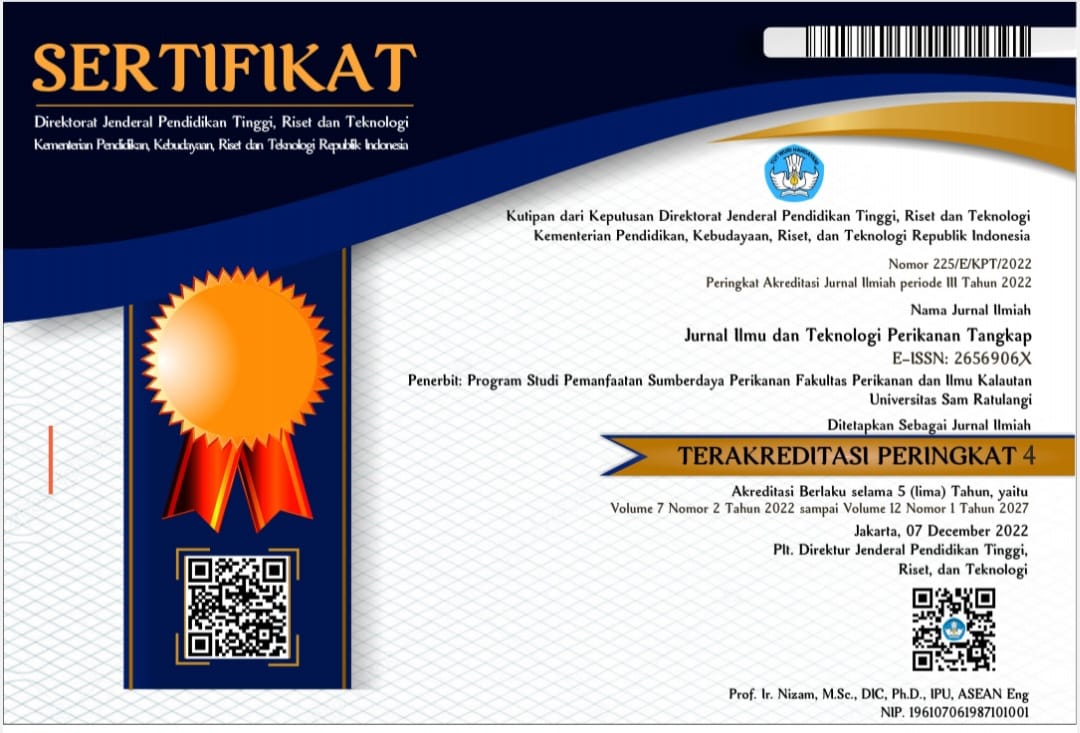Pengaruh bentuk atraktor terhadap jumlah penempelan telur Cumi-Cumi di perairan Desa Kalasey Satu Kecamatan Mandolang Kabupaten Minahasa
DOI:
https://doi.org/10.35800/jitpt.v7i1.37285Keywords:
Atraktor, cumi-cumi, penempelan, kapsul telurAbstract
Cumi-cumi merupakan salah satu inovasi pemanfaatan tanpa merusak lingkungan. Secara umum atraktor terdiri dari dua bentuk yaitu bentuk silinder dan bentuk kotak. Penelitian ini bertujuan untuk mengetahui jenis cumi-cumi yang menempel pada atraktor silinder dan atraktor persegi serta untuk Mengetahui apakah bentuk atraktor berpengaruh terhadap jumlah penempelan telur cumi-cumi. Adapun analisis data menggunakan metode Uji Beda Dua Mean Independent dengan rumus The separate model t-test.
Berdasarkan hasil identifikasi morfologis diperoleh informasi bahwa jenis telur cumi-cumi yang menempel adalah famili Loliginidae, yaitu genus Sepioteuthis lessoniana. Adapun hasil analisis menggunakan rumus The seprate model t-test menunjukan bahwa = 2,77 > = 2,13 hasil ini menjelaskan bahwa perlakuan bentuk atraktor menyebabkan perbedaan jumlah penempelan telur cumi-cumi, dimana atraktor bentuk silinder lebih baik dibandingkan dengan bentuk kotak
References
Anggraeni, L. dan Hapsari, T. 2015. Faktor-Faktor Yang Mempengaruhi Hasil Produksi Unit Penangkapan Jaring Cumi (Cast Net) Di Ppn Kejawanan Cirebon, Jawa Barat. Journal of Fisheries Resources Utilization Management and Technology Volume 3, Nomor 4, Tahun 2015, Hlm 41-46.
Baskoro, M. S. Sondita, M. F. A. dan Yusfiandayani, R. 2015. Efektivitas Bentuk Atraktor Cumi-Cumi Sebagai Media Penempelan Telur Cumi-Cumi (Loligo sp). Jurnal Kelautan Nasional. Institut Pertanian Bogor, 3, 177–184
Chodrijah, U. dan Budiarti, T. W. 2011. Beberapa aspek biologi cumicumi jamak (Loligo duvaucelli) yang didaratkan di Belanakan, Subang – Jawa barat. BAWAL. 3(6) : 357-362
Gunarso, W. 1985. Tingkah Laku Ikan dalam Hubungan dengan Alat, Metode dan Teknik Penangkapan. Institut Pertanian Bogor. Bogor
Iwata, Y. Ito, K. dan Sakurai, Y. 2010. Is commercial harvesting of spawning aggregations sustainable—The reproductive status of the squid Loligo bleekeri. Fisheries research, 102(3), 286-290.
Jamal, M. Asbar. dan Hasrum. 2017. Atraktro Ccumi-cumi: Teknologi Potensial dan Tepat Guna untuk Pemberdayaan Nelayan. Jurnal Balireso Vol. 2, No. 2
Jereb, F. and Roper, C. F. E. 2006. Cephalopods of the Indian Ocean. A review. Part I. Inshore Squids (Loliginidae) collected during the International Indian Ocean Expedition. Journal of Fish. 119(1): 91–136
Jereb, P. M. Vecchione, and Roper, C. F. E. 2010. Family Loliginidae. In P. Jereb and C. F. E. Roper, eds. Cephalopods of the world. An annotated and illustrated catalogue of species known to date. Vol 2. Myopsid and Oegopsid Squids. FAO Species Catalogue for Fishery Purposes. 4 (2):38–117.
Johnson, W. H, E. Louis, Delaney, C. E. Williams, Thomas Cole A. 1977. Principle of Zoology. Holt, Rinehart and Winston Inc. New York. V.14:501-516.
Kusnadi, A. Hermawan, U.E. dan Teddy Triandiza 2008. Moluska Padang Lamun Kepulauan Kei Kecil. Jakarta: LIPI Press.
Nabhitabhata J. 1996. Life Cycle of Cultured Big Fin Squid, Sepioteuthis lessoniana Lesson. Phuket: Phuket Marine Biological Center Special Publication 1–95 p.
Nazir, M. 2003. Metode Penelitian, Ghalia Indonesia. Nuraini R, EKa.
Nontji, A. 2002. Laut Nusantara. Djambatan. Jakarta: 93-110
Patty W., Pangalila, F., Kayadoe, M. 2019. PKM Nelayan Dalam Meningkatkan Produktifitas Sumberdaya Perikanan Dengan Teknologi Attractor Cumi di Perairan Desa Kalasey Dua, Kecamatan Mandolang Kabupaten Minahasa Provinsi Sulawesi Utara. Usulan Program Kemitraan Masyarakat. (PKM) Universitas Sam Ratulangi
Patty W., Pangalila F.P.T., Kayadoe M.E., Majore E., dan Dien H.V. 2021. Teknologi Attractor Cumi Rangka Besi: Upaya Meningkatkan Produktifitas Sumberdaya Perikanan di Perairan Desa Kalasey Dua, Kecamatan Mandolang Kabupaten. Jurnal Ilmu dan Teknologi Perikanan Tangkap. Vol.6. ejournal.unsrat.ac.id, https://ejournal.unsrat.ac.id/index.php/JITPT/article/view/24843
Roper C. F. E., M. J. Sweeney & C. E. Nauen, FAO. 1984. FAO Species Catalogue. Vol. 3. Cephalopods of The World. An Annotated and Illustrated Catalogue of Species of Interest to Fisheries. FAO Fish Synop., (125) Vol. 3: 1–277 p.
Rocha, F. A. Guerra dan A. F. Gonzalez. 2001. A review of reproductive strategies in cephalopods. Biological Review. 76 (1): 291304.
Syari, I. 2014. Interaksi Fungsional Penempelan Telur Cumi (Loligo chinensis. Gray, 1849) Pada Modifikasi Rumpon Atraktor Cumi Di Perairan Tuing Kabupaten Bangka. Tesis. Sekolah Pascasarjana Institut Pertanian Bogor, Bogor. 40 hal.
Suryabrata. S. Metode Penelitian. Jakarta: Rajawali, 1987
Sauer, W. H. H., Melo, Y. C., & De Wet, W. 1999. Fecundity of the chokka squid Loligo vulgaris reynaudii on the southeastern coast of South Africa. Marine Biology, 135(2), 315-319.
Tallo, E. 2006. Perbedaan Jenis dan Kedalaman Pemasangan Atraktor Terhadap Penempelan Telur Cumi-Cumi. Tesis. Sekolah Pascasarjana Institut Pertanian Bogor, Bogor. 47 hal.
Walsh, L. S., Turk, P. E., Forsythe, J. W., & Lee, P. G. 2002. Mariculture of the loliginid squid Sepioteuthis lessoniana through seven successive generations. Aquaculture, 212(1-4), 245-262.
Downloads
Published
How to Cite
Issue
Section
License
You are free to:
- Share — copy and redistribute the material in any medium or format
- Adapt — remix, transform, and build upon the material
- The licensor cannot revoke these freedoms as long as you follow the license terms.
Under the following terms:
- Attribution - You must give appropriate credit , provide a link to the license, and indicate if changes were made . You may do so in any reasonable manner, but not in any way that suggests the licensor endorses you or your use.
- NonCommercial - You may not use the material for commercial purposes .
- No additional restrictions - You may not apply legal terms or technological measures that legally restrict others from doing anything the license permits.
Notices:
You do not have to comply with the license for elements of the material in the public domain or where your use is permitted by an applicable exception or limitation .
No warranties are given. The license may not give you all of the permissions necessary for your intended use. For example, other rights such as publicity, privacy, or moral rights may limit how you use the material.








